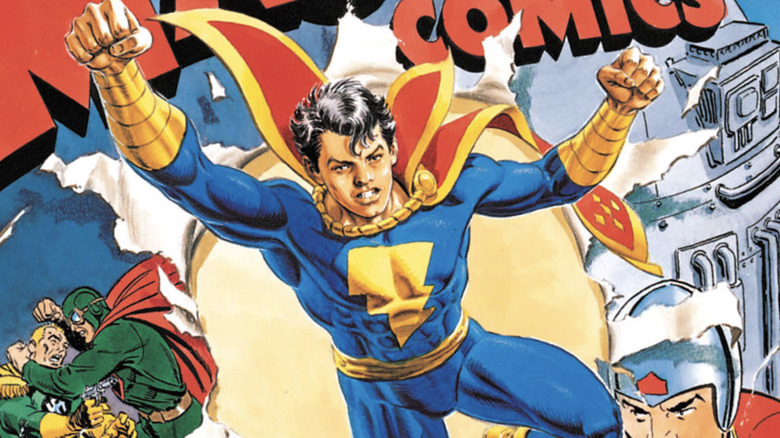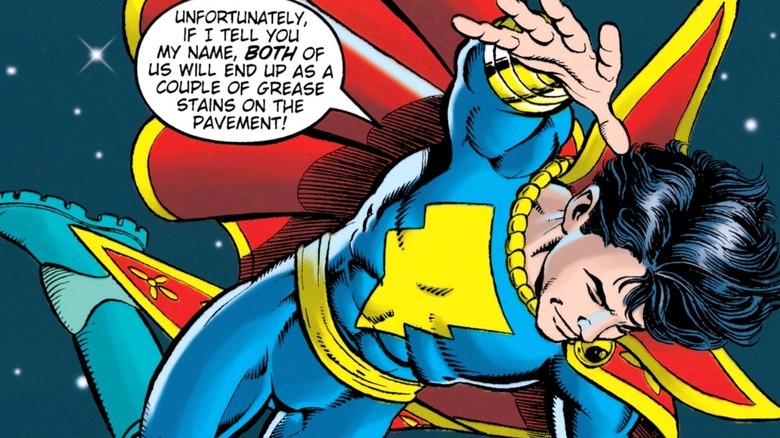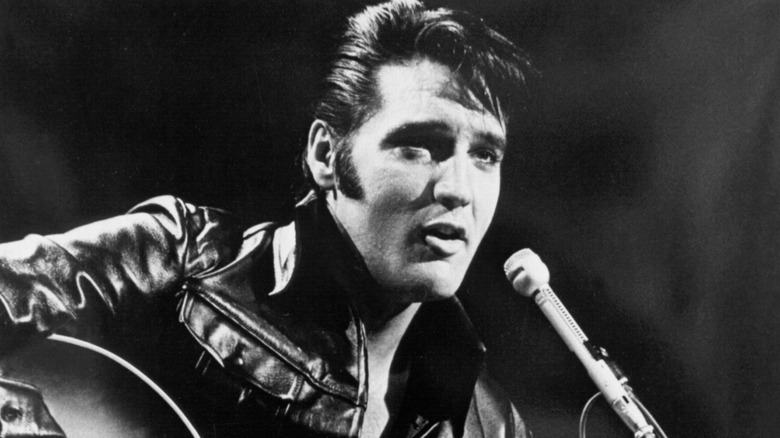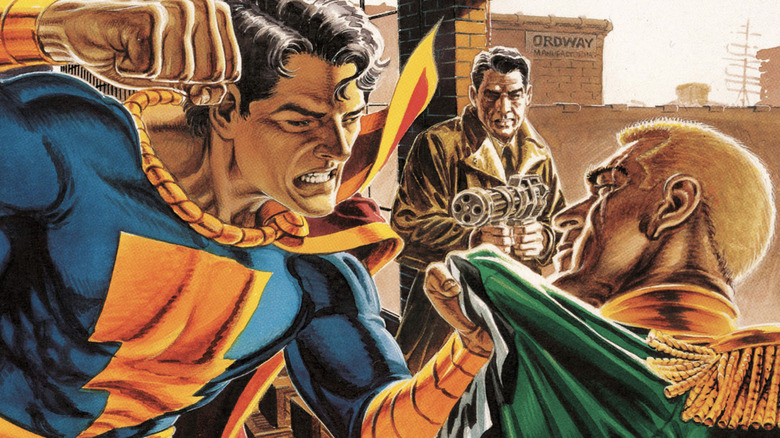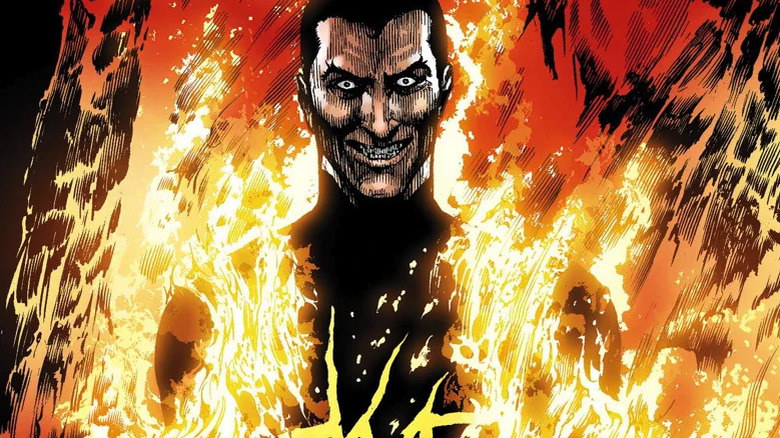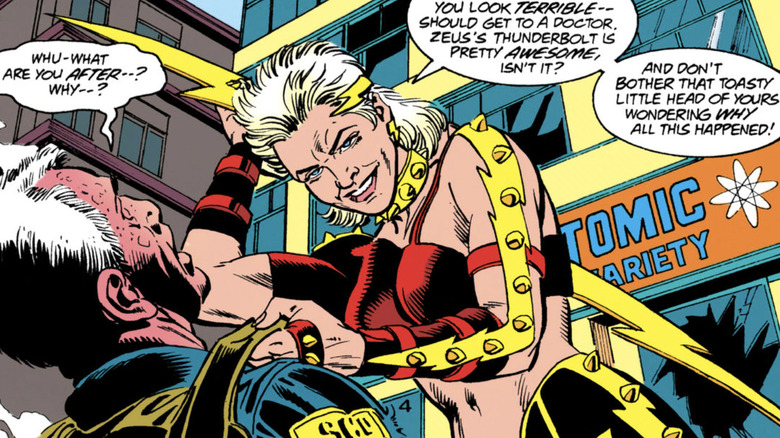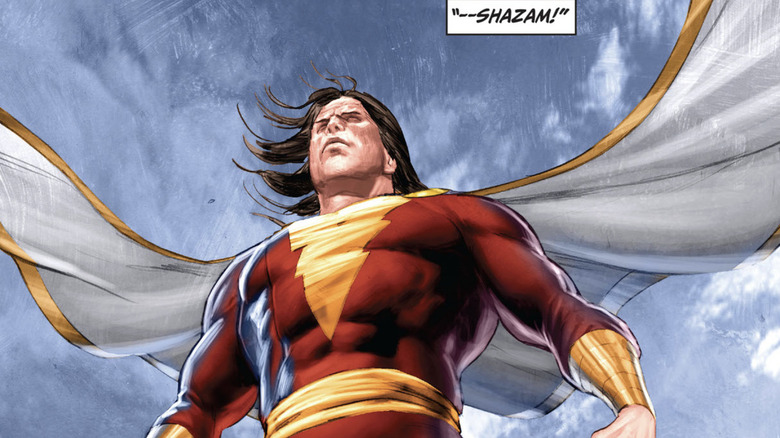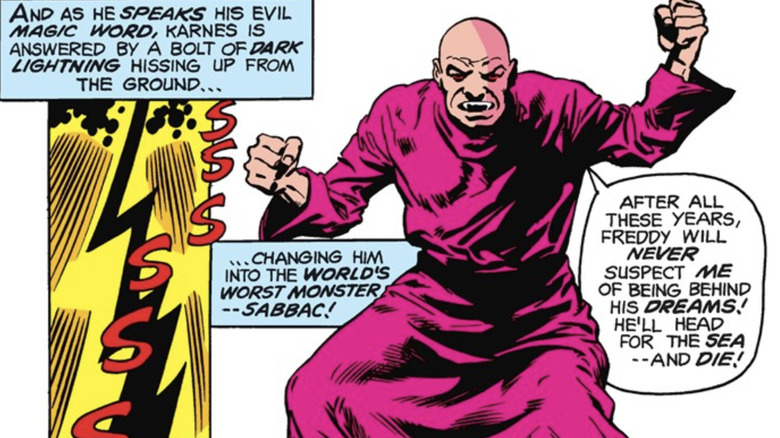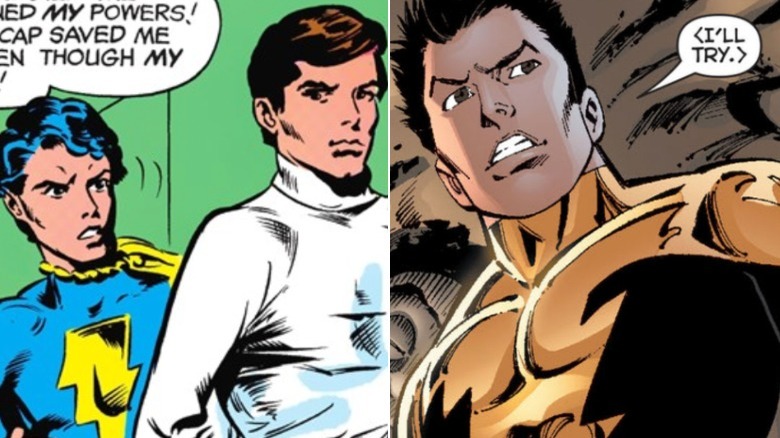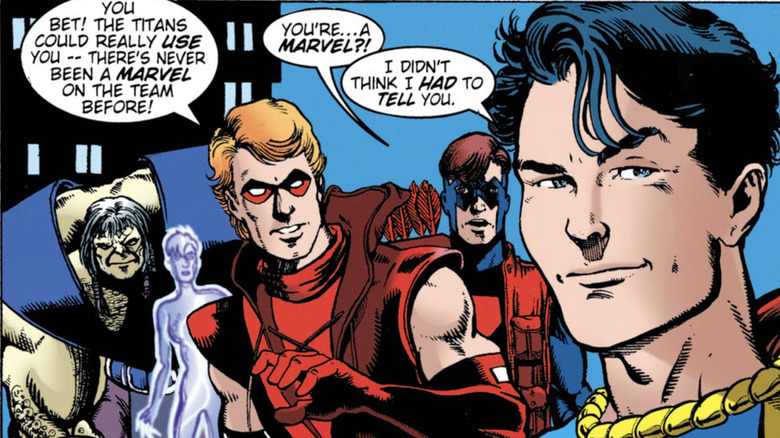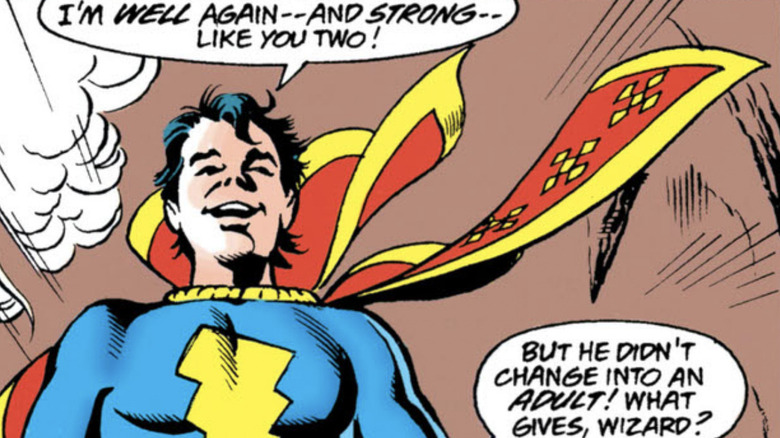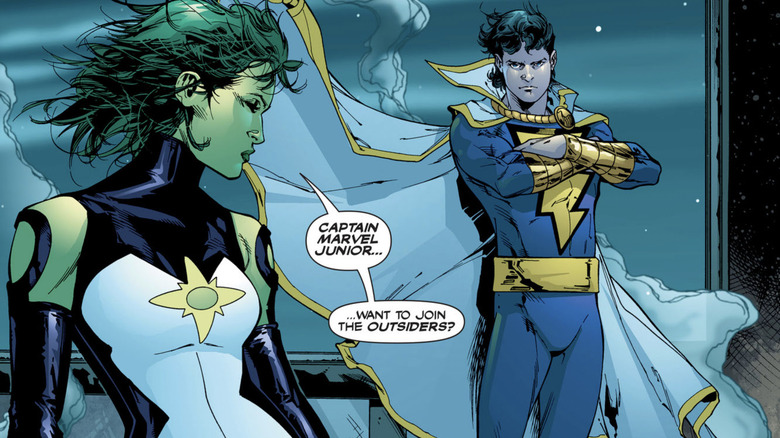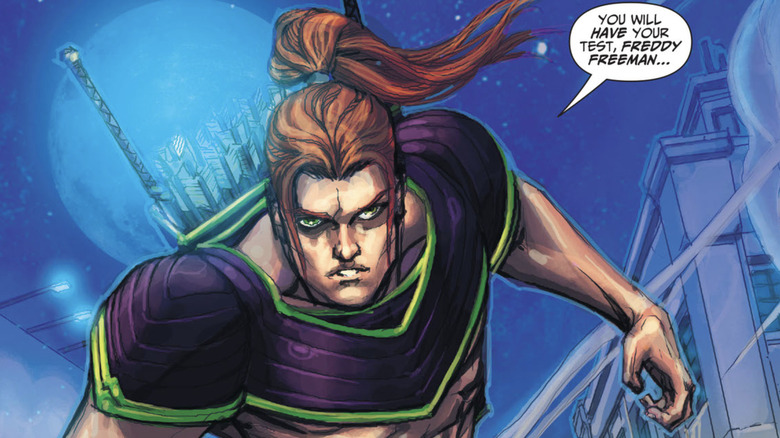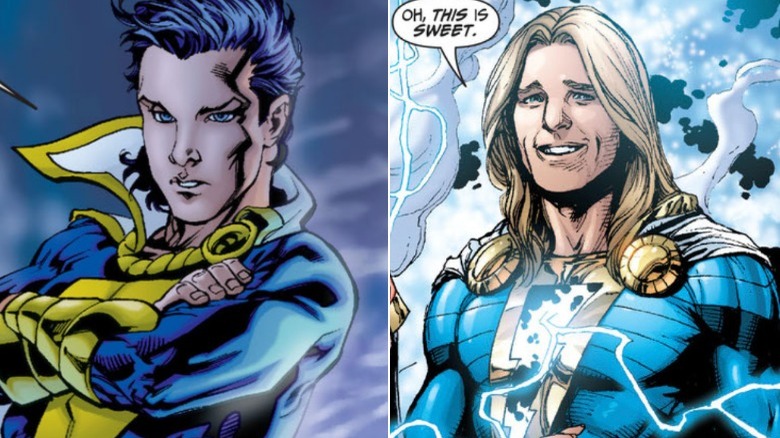13 Shazam Jr. Facts Only Huge Fans Know About The DC Character
Shazam isn't the only lightning-flinging caped hero in town. Since fairly early on in his superhero career, Billy Batson has been aided by several members of the Marvel Family, now known as the Shazam family. Among them is Freddy Freeman, aka Shazam Jr. (formerly Captain Marvel Jr.), who's been battling by Billy's side and on his lonesome since 1942's "Whiz Comics" #25. Freddy isn't the first crimefighter to share Shazam's powers and motif, or even the first male character to do so. But he is by far one of the most famous Shazam spin-off characters, alongside Billy's sister Mary.
Freddy (Jack Dylan Grazer, Adam Brody) plays a pretty big role in 2019's "Shazam!", becoming closer to Billy (Asher Angel, Zachary Levi) than any of their other foster siblings, and even gaining powers of his own in the film's climactic finale. "Shazam! Fury of the Gods" offers Freddy's superpowered alter ego even more screen time. With that in mind, we think it's time to call upon the lightning and get to know Shazam Jr. a little better. These are the facts only huge fans know about this dazzling DC superhero.
He can't say his superhero name
Introducing himself was a challenge for Freddy Freeman, back when he was known as Captain Marvel Jr. Unlike Billy and Mary Batson, who use the word "Shazam" to become Captain Marvel and Mary Marvel, Jr.'s magic word is "Captain Marvel" in his early stories — which means that saying his or Billy's superhero name either powers him up or changes him back into Freddy Freeman. As a result, Jr. has to be careful about uttering his marvelous moniker, lest he transform at the wrong moment.
Over the years, however, Freddy finds workarounds for this tricky situation. Naturally, he can get by simply referring to himself as "Jr.," but a creative solution appears in 1998's "Teen Titans" #20. After being called everything from "Lighting Lad" to "Marvel Boy" by his teammates, he finally adopts "CM3" as a nickname while on a date with Argent. Why "3?" Because at this point in DC's ever-changing continuity, Freddy is the third Captain Marvel to debut chronologically. Furthermore, this era's Mary Marvel calls herself "Captain Marvel" like her brother, thus unofficially making her "CM2."
The New 52 era rebooted Freddy as "Shazam Jr." This not only changed his magic word to "Shazam," it changed the rules around it, too. Now, Freddy only transforms if he says "Shazam" with altruistic purpose and conviction, as explained in 2012's "Justice League" #0.
How he inspired Elvis
While Shazam is often depicted as the most powerful member of the Shazam Family on the comics page, Shazam Jr.'s magic has pulled off a feat even Billy's hasn't: inspiring one of the most famous rock and roll legends of all time. As Elaine Dundy's "Elvis and Gladys" relates, Elvis Presley wasn't just a comic book fan, but a fan of Captain Marvel Jr. in particular. The book goes on to state that Jr. influenced everything from Elvis' hairdo to his body language while performing, and quite possibly the King's values as well. It's also been speculated that Elvis' caped "blue owl" suit and extensive usage of lightning bolt imagery were overt nods to Jr.'s look and powers.
Perhaps it's not surprising, then, that comics creators have returned the favor by depicting Jr. as an Elvis aficionado. In the alternate future series "Kingdom Come," for instance, a grown-up Freddy Freeman changes his superhero name to King Marvel — a clear reference to Elvis, who's famously referred to as the King of Rock and Roll.
His archenemy is an ideology
Many of Freddy's early adventures see him fight agents of the Axis Powers, his most personal foe being Captain Nazi. In most versions of Freddy's origin, Captain Nazi, alias Albrecht Krieger, robs Freddy of the ability to walk and the life of his grandfather. While Krieger shares many of Freddy's powers, including flight, super-strength and near-invulnerability, he is portrayed for decades as an otherwise mortal man. In the 1990s' "Power of Shazam!" series, Captain Nazi is frozen for decades to ensure he'll stay youthful when revived in the late 20th century. Furthermore, Freddy initially has every intention of killing Captain Nazi, implying that Albrecht is indeed mortal.
Yet the 2006 one-shot "Villains United: Infinite Crisis Special," a follow-up to the fan-favorite "Villains United" miniseries, suggests that killing Captain Nazi may be easier said than done. The dread captain surprises Black Adam by appearing alive and well after supposedly being murdered by the Red Hood. When Adam vocalizes his astonishment, Nazi responds, "I am an idea, Adam. You can't kill an idea like me so simply." Though vague, Captain Nazi's words suggest that, much like DC Comics' version of Uncle Sam is the living embodiment of the United States, Captain Nazi is a living incarnation of Nazi ideology.
He inspired a pretty evil villain
Captain Marvel may have been accused of being a Superman ripoff by DC Comics, but that didn't stop his series from dominating the competition — Supes included (per the Museum of Comic Book Advertising). It stands to reason he'd have imitators of his own. One of the most famous is Miracleman, a hero who, as "Back Issue" #34 explains, was directly inspired by Captain Marvel down to his original name of Marvelman. Just as Captain Marvel has the magic word "Shazam" and sidekicks Mary and Captain Marvel Jr., Miracleman had "Kimota" and youthful crimefighting allies Young Miracleman and Kid Miracleman.
While the similarities don't stop there, Miracleman and his sidekicks were taken in a unique direction by Alan Moore, as detailed by Vulture. When an atomic explosion makes Miracleman amnesiac and kills Young Miracleman, the Captain Marvel Jr. stand-in, Kid Miracleman, secretly chooses to continue his life in his superpowered state. Like Freddy, Kid Miracleman originally doesn't age when transformed. But spending all his time as Kid Miracleman causes his super-self to age to adulthood, while his human form, Jonathan Bates, stays 13. Without Miracleman to teach him responsible power usage, Kid Miracleman gradually becomes corrupt. Were Kid Miracleman at DC rather than Marvel, Freddy would certainly consider him a cautionary tale.
The woman who steals his powers
Freddy Freeman's had his share of romantic admirers, but one in particular gets a little too fixated on him. 1996's "The Power of Shazam!" #14 sees Shazam Jr. — then Captain Marvel Jr. — meet the post-"Crisis" version of Chain Lightning, a former Mary Marvel villain. After Freddy saves Chain Lightning from a leap off the Statue of Liberty, she's perhaps a little too grateful, flirting heavily with him on the spot. Her behavior then becomes more erratic, as she attacks Freddy and falsely accuses him of defacing Lady Liberty when a police officer appears. Eventually, Chain Lighting reveals she has dissociative identity disorder, and that one of her alternate personas is responsible for accidentally killing a pregnant woman. After a brief battle, Lightning's taken in by S.T.A.R. Labs for treatment — but not before she changes Jr. back into Freddy with a powerful electricity attack.
This unexpected transformation comes as both a literal and figurative shock to Freddy, who previously thought only magic lightning could change him. Chain Lightning again proves this isn't the case in 1998's "The Power of Shazam!" #42 when she steals the Marvel Family's magic, which gives each of her personalities a body of their own. While Billy eventually calls back the power in #46, every Chain Lightning personality except the benevolent one, Amy, enters Billy's mind, corrupting him as Captain Marvel until Mary Marvel helps him regain control.
He's the first mortal to use the name Shazam
Before he's known as Shazam, Billy Batson's superhero identity is Captain Marvel — a name he possessed long before any Marvel Comics character did. Thus, at this early point in the story, Shazam Jr. is Captain Marvel Jr. There is a character called Shazam in these days, though: The wizard who grants Freddy Freeman, Billy, Mary and the other members of the Marvel Family their powers.
However, a complication presented itself when Captain Marvel and company made their way from Fawcett Comics to DC Comics. In the years the Marvel Family had not been in publication, Marvel trademarked the "Captain Marvel" name (per Newsarama), meaning DC could not legally use "Captain Marvel" as a comic book title. While the characters' names remained the same, DC started naming their comics after the Marvel Family's wizard, Shazam. This got a little confusing, so DC tried finding a way around the issue by having Captain Marvel take Shazam's place when the wizard is temporarily killed by the Spectre in the "Day of Vengeance" miniseries. Rather than rename himself "Shazam," however, Billy shortens his superhero name to "Marvel," while Freddy, who essentially becomes Captain Marvel's replacement, changes his name to Shazam during 2006's "The Trials of Shazam!" series. Nowadays, the name "Shazam" belongs to Billy and Mary, but Freddy will always have bragging rights for getting the wizard's name first.
The major Shazam villain introduced in his series
"Shazam," as many comics fans know, is an acronym. Each letter represents a deity or otherwise extraordinary being from whom Shazam and his allies, including Shazam Jr., draw their power. Interestingly, some of their villains also adopt acronyms of their patrons for names. There's the pre-"Crisis on Infinite Earths" version of Ibac, for instance, whose dastardly traits come from such fear-worthy beings as Ivan the Terrible and Caligula (represented by the "I" and "C" in Ibac's name, respectively). Then there's Sabbac, whose patrons are almost exclusively demons or versions of the Devil: Satan, who provides him with super-strength; Aym, who makes him invulnerable, Belial, who bestows him with evil expertise; Beezlebub, who's behind his pyrokinesis; Asmodeus, who makes him brave; and Craeteis, who allows him to levitate.
While readers of 2006's "Superman/Shazam: First Thunder" might easily assume Sabbac is a Captain Marvel villain, that's not the case. What separates Sabbac from, say, Ibac, is that he begins as a Captain Marvel Jr. villain, first appearing in 1943's "Captain Marvel, Jr." #4. This Sabbac is Timothy Karnes, who's been the most consistent thorn in Freddy's side. Other Sabbacs include Ishmael Gregor, a mobster who kills Timothy to acquire his powers, and Bryer, opulent father of several school bullies, who's unwillingly taken over by the Seven Deadly Sins rather than the aforementioned demons.
His ever-changing siblings and doppelgängers
While Shazam Jr.'s grandfather is an ever-constant part of his family tree, Freddy's siblings switch around all the time. When Shazam Jr. moved from Fawcett to DC Comics, for instance, he soon gained a brother, Kid Eternity, from another company DC had purchased: Quality Comics. Kid Eternity, aka Kit Freeman, reveals in 1982's "World's Finest Comics" #280 that he actually died when Jr. was meant to, which is how Kit got the power to summon beings from history and myth.
Kid Eternity's connection to Shazam Jr. is undone after "Crisis on Infinite Earths," however, and Freddy gains a notorious foster brother in Kit's place: Timothy Karnes, the original Sabbac. This sibling tie doesn't last, as DC's New 52 era made Freddy the adoptive brother of the Vasquez children, including Billy and Mary Batson.
On top of all that, Shazam has an unofficial brother — or perhaps more of a cousin — in Amon Tomaz, aka Osiris. Like Freddy, Amon gained his powers as a teenager, but his are derived from the patrons of the wizard's original champion, Black Adam. Freddy and Amon have been both friends and foes at various points, due to Osiris' complicated moral compass.
He's the first Shazam family member to join the Teen Titans
Though Shazam is often depicted as a 12-year-old or teenager in his civilian form, his superpowered state resembles an adult, which explains why he hasn't often associated with the Teen Titans until recently. Conversely, since Shazam Jr. still looks like a teen, he's classic Titans material, and has been a member more times than readers might remember. First encountering the group in 1997's "Teen Titans" #4, Freddy joins the team led by the Atom. But he isn't offered membership until #17, when he helps the Titans fend off the xenophobic group the Veil.
Ever the teenager, Freddy soon goes on a date with Argent, but things sour when their romantic dinner goes awry. Things also get tense between Freeman and Risk. That friction intensifies when Freddy thinks Risk has murdered an opponent, Scorcher, in battle. It's eventually discovered that Risk has been framed, however, and Freddy helps rescue him and the other Titans from the H'san Natall alien race before leaving the team. This isn't the last iteration of the Teen Titans Freddy is part of: He joins Titans Los Angeles in 2000's "Titans Secret Files and Origins" #2.
His transformation doesn't always age him
One of the most recognizable characteristics of Billy Batson's transformation into Shazam is that his body changes into an adult's. While this is also true of Shazam Jr. as of 2013's "Justice League" #21, this has not been the case for most of Freddy Freeman's publication history. When the character was owned by Fawcett Comics, for example, his body's physical appearance didn't change when he became Captain Marvel Jr., earning him the nickname of "The World's Mightiest Boy." The same held true when the Marvel Family was licensed and bought by DC Comics, and even after the universe-rebooting "Crisis on Infinite Earths."
An explanation for why post-"Crisis" Freddy Freeman doesn't become older is given in 1995's "The Power of Shazam!" ongoing series. When Freddy first transforms, Mary expresses surprise that he doesn't age up like she and Billy do. The wizard Shazam clears things up by explaining that those who use his power change according to how they subliminally want themselves to look — which, in Freddy's case, is the way he appeared prior to being injured by Captain Nazi.
He's the only Shazam Family member to join the Outsiders
Shazam Jr. is quite the team player during his Captain Marvel Jr. days: Over the course of DC's post-"Crisis" era, he becomes part of more superhero teams than Captain and Mary Marvel. Other than the Titans and the Marvel Family, however, the team he sticks with longest is one no other Marvel's been part of: the Outsiders. As with the Atom's Titans, Freddy goes on an adventure with the Outsiders before actually joining in 2004's "Outsiders" #9 and 10. Jade, who assumes leadership of the team, formally invites Freddy to join in #28, right before Sabbac, souped up from bonding with the Seven Deadly Sins, returns. While Sabbac easily defeats the other Outsiders and guest-star Katana by corrupting them with the Sins, Freddy manages to stick Katana's Soultaker Sword into Sabbac's super-thick skin. This allows surprise visitor Donna Troy to finish the job by pushing the sword in deep enough to trap Sabbac within its blade.
Donna Troy soon recruits Freddy and several other Outsiders to tackle a mysterious cosmic storm in space, but Freddy abandons the mission when the Spectre's war on magic begins taking an adverse toll on him. With Katana's help, however, Freddy gets it together enough so the two heroes and Thunder can rescue Mary Marvel and Grace Choi from the Society. Freddy resigns some time later, just barely missing the Outsiders' black ops phase.
The time he swapped gods
While Mary Marvel has sometimes been an exception to this rule, the Shazam/Marvel family has typically been powered by the same six beings: Solomon, Hercules, Atlas, Zeus, Achilles, and Mercury. 2006's "The Trials of Shazam!" even has Freddy fight versions of these patrons so they can once again bestow him with their powers.
However, in that same series, a complication arises when Sabina murders Atlas, claiming his power as a result. Guided by Zeus' mortal form, Zareb, Freddy approaches Apollo, who reluctantly agrees to bequeath his power to Freddy and assume Atlas' old responsibilities should the young man beat Apollo in a sword duel. Apollo's altruism gets the better of him, however, and he decides to give Freddy 50 percent of his power before their battle's done. However, Apollo sends the other 50 percent to Sabina to pressure Freddy and Zeus to find someone else to substitute Atlas, so Apollo can resume life as a mortal. As Freddy is never shown finding an alternate candidate for Atlas, it's unclear if he keeps Apollo's powers long-term. Regardless, Jr. is the only member of the Shazam family who's ever used Apollo's powers in battle.
Just don't call it hair dye
While certain "Shazam!" characters have changed appearance over time, Billy Batson and Mary Marvel have stayed pretty physically consistent throughout the decades. For many years, this was also true of Freddy Freeman, who looked pretty much the same in 2010 as he did in 1941. Not even DC's biggest continuity-reshuffling event, "Crisis on Infinite Earths," alters Freddy much, as seen when he makes his post-"Crisis" debut in "The Power of Shazam!" ongoing.
Thus, it was fairly surprising when Freddy gained a new hairstyle and hair color in 2012. Rather than his classic short black hair, the Freddy Freeman of the New 52 sports a blonde 'do in "Justice League" #8. Setting this look apart even further is the fact that when Freddy transforms into Shazam Jr., his hair length increases significantly, which never used to happen back when he was Captain Marvel Jr. Combined with the fact that he now becomes an adult when switching into superhero mode, this is one of the biggest physical changes the character has undergone in over 70 years. Interestingly, the "Shazam!" film settles on an aesthetic compromise: Freddy's transformation ages him up, but his hair stays dark (though not quite black) and relatively short.
